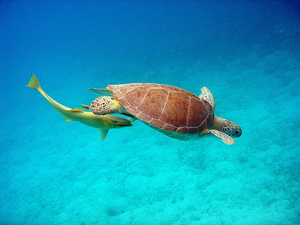Error processing SSI file
|
About Marine Protected Areas
 >
About MPAs > MPA Stories >
Virgin Islands Coral Reef National Monument >
About MPAs > MPA Stories >
Virgin Islands Coral Reef National Monument
Virgin Islands Coral Reef National Monument

Sea Turtle located within the Virgin Islands Coral Reef National Monument.
The Virgin Islands Coral Reef National Monument encompasses over half the island of St. John and almost all of Hassel Island preserving stories of the prehistoric past and over a hundred historic sites that together complete one the most undisturbed and comprehensive Caribbean landscapes.
Significant prehistoric sites are present on almost every beach and in every bay within the park. These archeological sites date from as early as 840 BC to the arrival of Columbus. These sites have given us a greater understanding of this Caribbean region's prehistory, and the religious and social development of the Taino culture that greeted Columbus. They have dramatically increased our understanding of the ancient rock art that is found throughout the Caribbean islands. Prehistoric Caribbean rock art demonstrates the close connection between ancient people and their environment.
The park also protects diverse marine and coastal habitats, including coral reefs, mangroves and tropical forests. Coral reefs in the Virgin Islands have suffered the highest amount of hard coral mortality from severe bleaching that began in fall 2005 and subsequent outbreaks of coral disease than from any other stressor over the last 40 years. In the past, hurricanes have caused localized destruction, and white band disease caused losses of over 90% of the primary shallow water reef-building coral.
Did you know?
The Machineel tree, found along the coast of the Virgin Islands Coral Reef National Monument, produces crab apple-like fruit that is poisonous. Even sap from the Machineel tree can cause an irritating skin rash. The tree is also called Death Apple. The underwater snorkel trail at Trunk Bay is an excellent place for beginners or anyone wanting to learn about marine life. Plaques along the trail describe the various species of fish, and provide information about the coral reefs.
Learn more/get involved:
Eat Sustainable Seafood. Around the world, fisheries are threatened with collapse due to unsustainable fishing methods and ecosystem destruction. When grocery shopping or dining out, choose seafood that is sustainable. Carry a sustainable seafood card and ask your local restaurants and markets to buy from sustainable fisheries. For more information, visit: http://www.fishwatch.gov/ and http://www.montereybayaquarium.org/cr/seafoodwatch.aspx Be Considerate of Ocean Wildlife & Habitats. Whether you're exploring the ocean by diving, surfing, boating or by relaxing on the beach, be sure to show your appreciation and clean up after yourself. Keep your distance from sea birds, mammals and other ocean wildlife so that you don't disturb their feeding or nesting grounds. Tread lightly on tide pools and other shore habitats. Don't remove rocks or corals. For more information, visit: http://www.nmfs.noaa.gov/pr/
|

